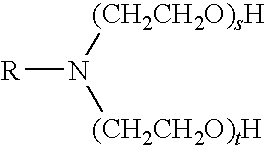Thickened compositions and method for thickening aqueous polymer compositions
a technology of aqueous polymer compositions and compositions, which is applied in the field of methods for thickening aqueous polymer compositions, can solve the problems of limiting the formulation latitude in terms of the weight solids of the aqueous system to be thickened, and affecting the thickness of the composition. , to achieve the effect of increasing the viscosity
- Summary
- Abstract
- Description
- Claims
- Application Information
AI Technical Summary
Benefits of technology
Problems solved by technology
Method used
Image
Examples
example 1
Thickener Example 1
[0074]A mixture of 35.0 g PEG (molecular weight 8000) and 60.0 g toluene was dried by azeotropic distillation. The mixture was cooled to 90° C., and 1.5 g HMDI and 0.1 g dibutyltin dilaurate were added. After 1 hour at 90° C. with stirring, 1.0 g di-n-octylaminoethanol was added. The mixture was then held at 90° C. with stirring for another hour. The resulting solid polymer was isolated after precipitation with hexanes. Mw was measured as 41,000.
example 2
Thickener Example 2
[0075]A mixture of 216 g PEG (molecular weight 8000) and 22.4 g Ethomeen™ 18 / 25 was heated to 115° C. under vacuum in a batch melt reactor for 2 hours. Ethomeen™ 18 / 25 is a bis(2-hydroxethyl)stearylamine with 25 total units of ethylene oxide. The mixture was cooled to 105° C., and 9.1 g IPDI and 0.5 g bismuth octoate solution (28%) were added. The mixture was then held at 105° C. with stirring for 20 min. The resulting molten polymer was removed from the reactor and cooled. Mw was measured as 21,000.
example 3
Thickener Example 3
[0076]A mixture of 50.0 g PEG (molecular weight 8000) and 80.0 g toluene was dried by azeotropic distillation. The mixture was cooled to 90° C., and 2.2 g HMDI and 0.1 g dibutyltin dilaurate were added. After 1 hour at 90° C. with stirring, 1.4 g di-2-ethylhexylaminoethanol was added. The mixture was then held at 90° C. with stirring for another hour. The resulting solid polymer was isolated after precipitation with hexanes. Mw was measured as 47,000.
PUM
| Property | Measurement | Unit |
|---|---|---|
| Fraction | aaaaa | aaaaa |
| Fraction | aaaaa | aaaaa |
| Acidity | aaaaa | aaaaa |
Abstract
Description
Claims
Application Information
 Login to View More
Login to View More - R&D
- Intellectual Property
- Life Sciences
- Materials
- Tech Scout
- Unparalleled Data Quality
- Higher Quality Content
- 60% Fewer Hallucinations
Browse by: Latest US Patents, China's latest patents, Technical Efficacy Thesaurus, Application Domain, Technology Topic, Popular Technical Reports.
© 2025 PatSnap. All rights reserved.Legal|Privacy policy|Modern Slavery Act Transparency Statement|Sitemap|About US| Contact US: help@patsnap.com

